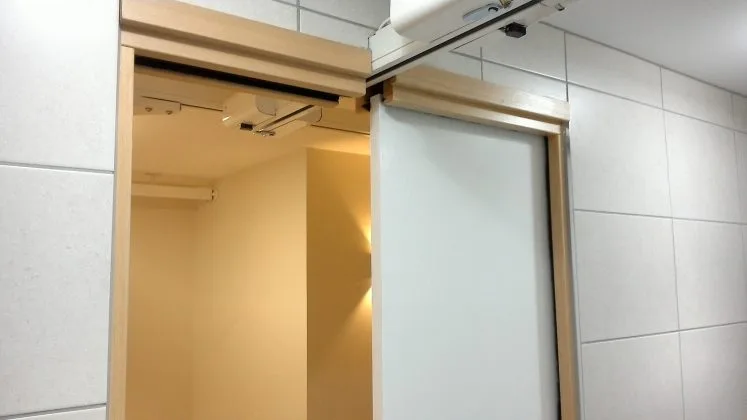How to Solve Ceiling Hoist Track Conflicts with Curtain Rails and Doorways
Posted on 23 March 2017 By Aaron Stretton

In This Article
Any architect who has worked on a project for a hospital or another multi-user healthcare environment will have encountered these…
Any architect who has worked on a project for a hospital or another multi-user healthcare environment will have encountered these all-too-familiar problems. We need hoist tracking so that patients can be moved around or between rooms with ease, and we need curtain rails so that their privacy can be upheld.
We also need to move patients from one room to another, which means moving a hoist through a doorway. However, this creates a real issue when it comes to planning track layouts, because the hoist cannot pass through the curtain rail, and the tracking cannot simply pass through a doorway.
But do not despair, because there are some solutions.
Making a Gap in the Hoist Tracking
To allow the hoist system and curtain rails to co-exist harmoniously, you need to create a gap for one or the other to pass through. Making a gap in the hoist tracking might sound borderline dangerous, but we can assure you that it’s easy and safe.
The AirGlide360 Curtain System has been designed specifically to tackle this issue. This clever creation allows X-Y hoisting systems and hoist units to pass below curtain rails on one of the fixed parallel rails. This is the best solution for tracking that is hung from the ceiling.
The track is hung lower than the curtain rail, and the gaps are big enough to allow the curtain to pass through them but small enough to make no difference to the smooth-travelling of the twin trolley hoist unit.
Making a Gap in the Curtain Rail
Creating a gap in the curtain rail sounds equally as alarming — surely the curtain will just fall straight off! But what if there’s a way to make a gap in the rail that can close when the hoist has passed through? Where there’s a will, there’s a way.
This solution comes in the form of Yewdale’s Movagate. This simple mechanism acts as a gate, allowing the curtain rail to open and close as the hoist travels through. The Movagate is ideal for use with Inset Tracking, so it’s a great option for rooms that perhaps have lower ceilings. It features sprung hinge that allows the hoist to simply push it open, and it’s fitted with a magnet so it can snap shut. A simple solution to a prominent problem.
Doorway Details
Similarly with a doorway, the hoist tracking cannot just go straight through it. It would obstruct the door from opening and closing, and you can’t exactly end hoisting track on one side of the door, and then start it again on the other with no link in-between!
We have a solution for this problem too. First of all, we can put a transit coupling system in the header of the door. This is a fixed gate that is fitted with magnets and sensors that will lock the traverse track of an X-Y system into place when the hoist is near. This means that the hoist can move along the traverse rail, and through the doorway on the fixed track.
There is a slightly more outlandish solution for doorways. You can cover two rooms (that are next to one another) with one X-Y system. To do so, there needs to be a gap between the top of the wall and the ceiling, giving the traverse rail enough room to pass through. This means that the hoist can cover both rooms and it can travel through a doorway because it is already installed above it. We can fit hoists like this if desired, however it does mean that the wall will not connect with the ceiling.
Planning track layouts doesn’t have to be so hard, especially if you include a hoisting specialist from the start. They can help advise you with the devices and layouts we’ve listed above, and clashes with curtain rails and doorways can be a thing of the past. Nevertheless, if you have any queries or are just looking for some advice on ceiling track layouts, then get in touch with us!
Speak to The Experts
Need assistance with product enquiries, general inquiries, or product support? Our Phonelines are open 9am - 5pm Monday to Friday
0113 519 0319
Or, fill out the form for a call back.
